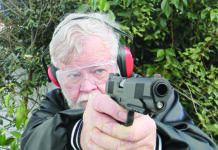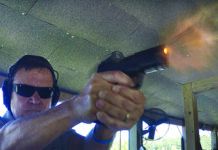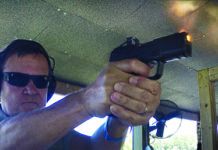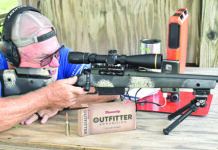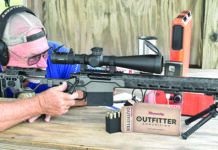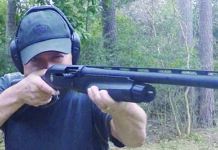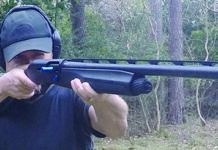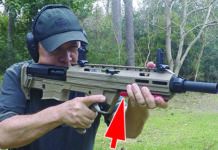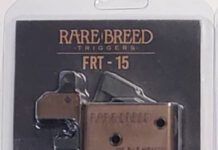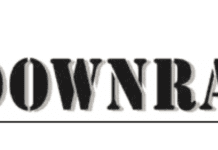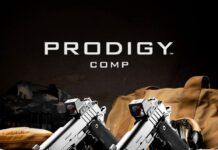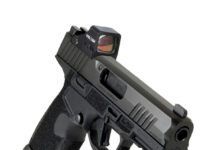Close in importance to the most basic needs — food, water, and shelter — is the ability to protect yourself from threats. Concealable, compact, and powerful handguns give us peace of mind in a dangerous world.

There is no doubt there are more effective cartridges than the 9mm Luger, but the 9mm is far more powerful than any 32 ACP or 380 Auto cartridge, and it holds more rounds than a compact 38 Special revolver. The 9mm is a powerful cartridge with good performance that will get the job done, given adequate shot placement. A compact handgun with good sights, a decent trigger, and ergonomic controls is a stalwart companion in difficult times. So we tested a quintet side by side to get an idea about what we would buy, then relay those impressions to Gun Tests readers. The pistols tested are unique in many ways, but they share a few common features. Takedown, trigger action, and slide-lock designs differ. Each may fit your needs more than the others, but there are a couple at the top of the heap. Our test handguns chambered in 9mm Luger were the following:
- Bersa BP9MCC, $295
- Honor Defense Honor Guard HG9SCF FIST, $400
- Ruger EC9s 3283, $231
- S&W M&P9 Shield Battleworn Coating, $250
- Taurus G2S 1-G2S931, $204
Slim Line 9mm Pistol Range Data
| Jesse James Ammo Inc. 124-gr. JHP | Bersa BP9MCC | Honor Defense FIST | Ruger EC9s | Smith & Wesson Shield | Taurus G2S |
| Average velocity | 1001 fps | 980 fps | 967 fps | 999 fps | 980 fps |
| Muzzle energy | 275 ft.-lbs. | 264 ft.-lbs. | 257 ft.-lbs. | 274 ft.-lbs. | 264 ft.-lbs. |
| Smallest group | 2.9 in. | 2.25 in. | 1.5 in. | 2 in. | 2.25 in. |
| Average group | 3.4 in. | 2.7 in. | 2.1 in. | 2.5 in. | 2.6 in. |
| Gorilla Ammunition 115-gr. JHP | |||||
| Average velocity | 1070 fps | 1029 fps | 1045 fps | 1065 fps | 1049 fps |
| Muzzle energy | 292 ft.-lbs. | 270 ft.-lbs. | 278 ft.-lbs. | 289 ft.-lbs. | 280 ft.-lbs. |
| Smallest group | 2 in. | 2.6 in. | 2 in. | 2.5 in. | 2.3 in. |
| Average group | 2.6 in. | 3 in. | 2.5 in. | 3 in. | 2.7 in. |
| Black Hills Ammunition 115-gr. EXP | |||||
| Average velocity | 1122 fps | 1090 fps | 1081 fps | 1101 fps | 1115 fps |
| Muzzle energy | 321 ft.-lbs. | 303 ft.-lbs. | 298 ft.-lbs. | 309 ft.-lbs. | 317 ft.-lbs. |
| Smallest group | 2.8 in. | 1.9 in. | 1.7 in. | 2.2 in. | 2.35 in. |
| Average group | 3.3 in. | 2.3 in. | 2.3 in. | 2.8 in. | 2.9 in. |
| We averaged the results from three five-shot groups for accuracy. The groups were fired at 15 yards. We recorded velocity with a Competition Electronics Chronograph. Range for velocity testing is 10 feet. Temperature at the time of testing ranged from 94 to 103 degrees. All groups were fired with an O.H. Products Bullshooter Pistol Rest at 25 yards (#666-100-013WB, $58 from Brownells.com). Ammo sources: Jesse James Ammo, Inc. 124-grain JHP ($14.24/20 SportsmansGuide.com); Gorilla Ammunition 115-grain JHP ($33.69/20 CheaperThanDirt.com); Black Hills Ammunition 115-grain EXP ($15/20 rounds LuckyGunner.com). | |||||
Bersa BP9MCC 9mm Luger, $295
GUN TESTS GRADE: A-
The pistol is reliable, feels good in the hand, and offers excellent practical handling in fast-paced drills. Some of the features, such as the magazine safety and locking action, were extraneous but did not affect performance. We liked the fit and finish. The ramped barrel offers a degree of safety with heavy loads. We would have liked more accuracy, but the pistol is adequate for most chores. The racking effort is greater than on other handguns.

| ACTION | Short-reset double action only |
| LENGTH | 6.35 in. |
| HEIGHT | 4.8 in. |
| MAX WIDTH | 0.94 in. |
| WEIGHT UNLOADED | 21.5 oz. |
| WEIGHT LOADED | 24 oz. |
| BARREL | 3.3 in., polygonal |
| CAPACITY | 8+1 |
| MAGAZINES | (2) 8-round |
| SLIDE | Matte-black blued steel |
| SLIDE RETRACTION EFFORT | 17.5 lbs. |
| FRAME | Matte-black polymer |
| FRONT STRAP HEIGHT | 2.4 in. |
| BACK STRAP HEIGHT | 3.4 in. |
| GRIP THICKNESS MAX | 0.95 in. |
| GRIP CIRCUMFERENCE MAX | 5 in. |
| FRONT SIGHT | SIG type, dovetailed |
| REAR SIGHT | Glock type, dovetailed |
| SIGHT RADIUS | 5.6 in. |
| TRIGGER PULL WEIGHT | 4.2 in. |
| TRIGGER SPAN | 2.4 in. |
| SAFETIES | Drop, trigger, action lock, magazine |
| WARRANTY | 1 year; unlimited for original purchaser |
| WEBSITE | Bersa@EagleImports.com |
| TELEPHONE | (732) 493-0333 |
| MADE IN | Argentina |
Above is our price from BudsGunShop.com. BP9MCC stands for Bersa Pistol 9mm Concealed Carry. When we ordered the BP9MCC, there were price variations as high as $313, but those models differed only in frame color. We could have had a nickel-plated slide for three more dollars, which may have been a good deal. We chose the least expensive product.

Bersa enjoys an excellent reputation for its small double-action-first-shot pistols. The BP9MCC is a completely different design from those, however. It is a departure from the 380 pistols or the Thunder full-size handguns. The frame is polymer, and the pistol uses a striker-fired action. The pistol was introduced long before Glock offered its slim-line G43 and offers a slim frame and compact grip. The blued-steel slide holds a 3.3-inch barrel. The rear of the slide has the Glock look with an action cover similar to the Glock, and the ejector and barrel lock up are also similar to the Glock. The rear cocking serrations are angled forward and work well. The slide is beveled and rounded on the top, a distinctive touch compared to the other handguns. In the modern fashion, the recoil guide rod features heavy-recoil-spring technology and a steel recoil rod. During testing, the pistol proved to be a light kicker for its weight, so the recoil-guide assembly works. A trade off is greater effort to rack the slide. The sights are atypical for a small pistol, with dovetailed sights both front and rear. The front post holds a single white dot, while the rear has a small dot on each post. These sights proved to work well in all testing, from firing for absolute accuracy to combat shooting.

The polymer frame offers a good contrast of abrasion and adhesion. The pebble-grain grip frame sides offer a hold for the palm, while wedged cuts in the front strap and rear strap offer good gripping surfaces. The frame narrows at the top to allow for a shorter trigger reach, a feature we appreciated. Just above the forward section of the rounded trigger guard are two pebbled areas, one on each side. They may be used to rest the finger tip as you keep the finger off the trigger before you fire.

The magazine release is ambidextrous. The magazine release is protected by a raised section of the frame. This magazine release is positive in operation and secure. The steel 8-round magazines are well made. The frame features a reasonably-sized rail for mounting a combat light, a good feature that the Smith & Wesson Shield, Honor Defense Honor Guard, and Ruger EC9s do not have. The pistol features a loaded-chamber indicator. This is a small lever that raises when a round is chambered. Both visual and tactile observation tell you when the gun is loaded. There is a key-controlled locking device on the slide. We don’t care for these, but some people do. It is a feature for long-term storage. There is also a magazine safety that prevents the BP9MCC from firing if there is no magazine inserted. This is a case of the technical over the tactical, but some folks like the idea of a magazine safety.

Disassembly isn’t difficult, but it is old school. The slide is retracted to a point where witness marks on the slide and frame meet, and the slide-lock lever is pressed out. The pistol was stiff at first, but after a break-down or two, it loosened up.
The trigger system is a unique feature and one that took acclimation even for our most experienced shooters. There are very good shots among the raters, and all agree accuracy potential is there, but only for those who practice. (We also value and use the opinions of less-experienced shooters because newbies make up much of the market for handguns.) The trigger is a short-reset double-action-only style. There is a safety feature similar to the Glock; however, there is no lever set in the face of the trigger. As one rater pointed out, this may make the Bersa more susceptible to lateral discharge, but we weren’t able to create that experience. The trigger pivots 0.25 inch on a steel roll pin. This action releases the safety. Once the safety is released, actually breaking the trigger against the sear requires 3.7 pounds of press. The total weight of pull is about 4.2 pounds average. This trigger action feels lighter than the others and offers a clean break. There is no creep or backlash, and reset is fast. The trigger need not return completely to battery. You keep the trigger to the rear and keep firing with a clean break.

To evaluate the 9mm pistols used in this test, our shooters fired the combat course with a handload consisting of a 115-grain plated roundnose bullet over 4.7 grains of W244. The Bersa exhibited 1109 fps with this load, so it is a full-power training load. We also used the Jesse James Ammo’s 124-grain JHP, the Gorilla Ammunition 115-grain JHP, and the Black Hills Ammunition 115-grain EXPs. We ran 100 rounds in each pistol on the combat course, and a magazine of each hollow point in firing offhand at 10 yards to test reliability. The three factory loads were used for accuracy testing from a solid bench rest.

For most raters, the pistol offered a full firing grip. For some, the small finger rested on the magazine basepad. The magazines were easy to load from start to finish, a good point for the Bersa. In firing 100 rounds on the firing range at 7, 10, and 15 yards, the pistol never failed to feed, chamber, fire, or eject. The BP9MCC came on target quickly and offered good heft. Recoil was never uncomfortable, though we could tell the handload was hotter than two of the three factory loads tested. Burning a magazine down and then quickly reloading was positive with the generous magazine release and slide lock. The pistol fired about 1 to 1.5 inches high with most loads. The Jesse James loading, at 1001 fps, struck to the point of aim. The Bersa demonstrated the highest velocities of the five pistols tested. Perhaps the polygonal rifling had a bearing on this.

Firing from a solid benchrest position, we expected good accuracy due to the Bersa’s good sights and excellent trigger. What we found was the BP9MCC was the least accurate handgun of the test at 15 yards instead of 25 yards, since these are lightweight handguns designed for personal defense. The most accurate load in the Bersa was the Gorilla Ammunition 115-grain JHP at 2.6 inches. The Jesse James 124-grain JHP was least accurate at 3.4 inches. While this isn’t impressive, it would be adequate for most threat management.
Our Team Said: We prefer a more accurate handgun, and there was one in the test that we liked better. Also, we would have preferred a manual safety or trigger lever.
Honor Defense Honor Guard HG9SCF FIST 9mm Luger, $400
GUN TESTS GRADE: A-
The FIST option (Firearm Integrated Standoff) is viable. We tested it against paper and against barricades with excellent results. The trigger action was heavy and accuracy not at the top.

| ACTION | Double action only |
| LENGTH | 6.6 in. |
| HEIGHT | 4.8 in. |
| MAX WIDTH | 1.2 in. |
| WEIGHT UNLOADED | 23 oz. |
| WEIGHT LOADED | 26 oz. |
| BARREL | 3.2 in. long, stainless steel; ferric nitro-carburized finish; 1:10 RH twist |
| CAPACITY | 8+1 |
| MAGAZINES | (2) 8-round |
| SLIDE | Stainless steel; ferric nitro-carburized finish; front & rear serrations |
| SLIDE RETRACTION EFFORT | 13.5 lbs. |
| FRAME | Polymer over stainless-steel modular chassis; two modular backstraps, black polymer grips |
| FRONT STRAP HEIGHT | 2.45 in. |
| BACK STRAP HEIGHT | 3.2 in. |
| GRIP THICKNESS MAX | 0.9 in. |
| GRIP CIRCUMFERENCE MAX | 5.3 in. |
| FRONT SIGHT | Bright-orange dot insert, post |
| REAR SIGHT | Wide-notch |
| SIGHT RADIUS | 5.3 in. |
| TRIGGER PULL WEIGHT | 7 lbs. |
| TRIGGER SPAN | 2.6 in. |
| SAFETY | No manual safety |
| WARRANTY | Limited lifetime |
| WEBSITE | HonorDefense.com |
| TELEPHONE | (678) 943-8035 |
| MADE IN | USA |
This was a recent price from BudsGunShop.com. Honor Defense is a veteran-owned company that first began manufacturing handguns in 2016. The pistols are single-stack designs chambered in 9mm Luger. There is a long-slide variation that accepts a combat light, but the pistol tested is the most interesting, we feel. This handgun features an extension of the frame that is designed to prevent the pistol from failing to function if the pistol is jammed into an adversary’s body and fired. This is a shortcoming of the automatic versus the revolver. The revolver may be used as a belly gun; that is, put in the other guy’s belly and fired as needed. So may the automatic, but it might only fire once because it can’t go back into battery. The Honor Guard line is filled with features designed purely for personal defense, and the handguns have much merit in this regard. These are striker-fired pistols with a polymer frame.

The pistol features a 3.2-inch barrel and no external safeties. An advantage is that most of the components are made from stainless steel, so corrosion is less of an issue than on a blued gun. The slide features cocking serrations that run from the front to the rear. The new Beretta APX uses a similar design to accomplish the same purpose. With cold, sweaty, or bloody hands, the Honor Defense Honor Guard 9mm offers plenty of gripping surface. If you need more leverage to rack the slide, the slide may be racked by jutting the front face of the rear sights against the belt or boot heel. While we have never had to do, so many veterans like this feature. It certainly doesn’t hurt anything, and it is better to have it and not need it than the reverse.

The top of the slide features a bright-orange front dot sight and white-outline rear sight. These were the best sights of the test. The pistol features a stainless-steel barrel and stainless striker assembly and housing. The action is modular and may be removed en bloc. This is a good feature for cleaning and maintenance. The frame treatment is unique. The texture is coarse but does not abrade the hand when firing. Adhesion and lack of abrasion are therefore excellent. There is little that is smooth on the frame. The teardrop-shaped magazine release is ambidextrous. The grip is indented to make for a shorter trigger reach.

There is a roll pin that allows changing the backstrap, an advantage the other pistols do not have. The two panels are either flat or arched and should accommodate most hand sizes. Since this is a compact frame, most hands will work well with either insert, but fine-tuning the grip doesn’t hurt. The backstrap covers the magazine. This is a better feel than the hand contacting the magazine on firing. There is no provision for a light.

Take down is simple. There is a lever that is rotated on the frame to disassemble the pistol. This system is SIG- or Beretta-like in simplicity, and we preferred it over the Ruger, Taurus, and Bersa systems, and equal to the Smith & Wesson build. The Honor Guard features a slide lock that isn’t difficult to use. Honor Defense states that the slide lock isn’t a slide release. To run the pistol in combat shooting, the drill is to replace the magazine and use the slingshot method to release the slide by grasping the slide at the rear and letting it run forward. Some of the raters could release the slide by using the slide lock; some could not. A previous crew testing a different Honor Defense 9mm found this a demerit. We did not. Considering how many small pistols have a problem with the shooter allowing his or her thumb to run into the slide lock and lock the slide back during a firing string, the Honor Guard design is valid. The slide is easily grasped by the generous cocking serrations and released to load the pistol.

The trigger action is heavier than we like at 7.0 pounds, but it breaks cleanly enough with a sharp reset.
In its literature, Honor Defense recommends a 150-round break-in period for its pistol. We respect this recommendation, but we also expect modern pistols to come out of the box running. This is our third Honor Guard pistol, and all came out of the box ready to fight.

The FIST pistol was tested with the same loads as the other handguns and combat firing was conducted first. We stressed speed loads and firing quickly at center mass on intruder-sized targets. The Honor Guard is easily the most comfortable handgun to fire and use, our shooters said. We center-punched the target on demand with the Honor Guard and found the orange-dot front sight stayed on the target well. Running the pistol empty, doing a speed load, and then grasping the rear of the slide to release the slide and make the pistol ready proved faster and more secure than the usual tilting of the hand to one side to engage the slide lock. Only the Bersa BP9MCC, with its generous slide lock, approached the ability of the Honor Guard FIST for speedy loading.

When firing the FIST pistol, we found it difficult to create a viable means of testing the FIST offset piece on the frame, but it definitely has merit. In fact, we found an advantage that Honor Defense has not advertised. When firing from a barricade, the shooter must be careful not to jam the pistol into the barricade and push it out of battery. This wasn’t possible with the Honor Defense Honor Guard FIST. You could push the lower frame against a barricade and fire without danger of the pistol being rammed out of battery. If we were going to purchase an Honor Defense handgun, this would be the first choice, especially because there is no surcharge for the FIST option.

Likewise, the pistol is easily the most comfortable to fire of the five 9mm handguns. The Honor Guard 9mm is designed for use with +P and +P+ loads, and it is strong enough to take these loads, according to the company. While the Honor Guard is slightly larger than the other pistols, when the measurements are compiled, it is only by a few tenths of an inch here and there, and none of the handguns are pocket pistols per se. This is a gun for shooters, as one of the raters noted, even though it isn’t the most accurate handgun we tested. Fired from the benchrest, the heavy trigger weighed against us. This pistol is accurate enough for personal defense but is not a tack driver by any means. The best group at 15 yards, with the Black Hills 115-grain EXP, was 2.3 inches, with the others larger. Even with a 3-inch group, this means that each bullet should land within 1.5 inches of the point of aim.

There is no option for mounting a combat light, so we gave it a half-point demerit. Also, we recognize it would be difficult to design the pistol to accept a combat light and utilize the FIST option, but then, we are hard to please, in support of our readers.
Our Team Said: The Honor Guard doesn’t place the technical over the tactical. The large cocking serrations, good sights, excellent frame treatment, and complete reliability make it a good choice for personal defense. The FIST option is so unusual there really isn’t anything to compare it against.
Our police and military raters felt the FIST offset was more important than a light-bearing option for civilian personal defense. This is the pistol that we recommend for personal defense among the five tested, although it is also the most expensive.
Ruger EC9s 3283 9mm Luger, $231
GUN TESTS GRADE: B-
The EC9s was the most accurate handgun of the test, which says a lot for the handgun despite its light weight. We question saving forty dollars and giving up superior sights, but some of us are on a tight budget. We like the manual safety. We feel that some shooters will be discouraged from cleaning the piece because the takedown isn’t as simple as other handguns.

| ACTION | Double action only; striker fired |
| LENGTH | 6 in. |
| HEIGHT | 4.5 in. |
| MAX WIDTH | 1.05 in. |
| WEIGHT UNLOADED | 17.1 oz. |
| WEIGHT LOADED | 19.6 oz. |
| BARREL | 3.12 in. long, alloy steel; 1:10 RH twist; 6 grooves; chamber-inspection port, black-oxide finish |
| CAPACITY | 7+1 |
| MAGAZINES | (1) 7-round; finger-grip, extension floorplate |
| SLIDE | Alloy steel; black-oxide finish |
| SLIDE RETRACTION EFFORT | 13 lbs. |
| FRAME | Black glass-filled Nylon; checkered side panels |
| FRONT STRAP HEIGHT | 2.3 in. |
| BACK STRAP HEIGHT | 2.7 in. |
| GRIP THICKNESS MAX | 0.97 in. |
| GRIP CIRCUMFERENCE MAX | 5 in. |
| FRONT SIGHT | Integral, rear serrations |
| REAR SIGHT | Integral, rear serrations |
| SIGHT RADIUS | 4.7 in. |
| TRIGGER PULL WEIGHT (DA) | 6.2 lbs. |
| TRIGGER SPAN (DA) | 3.3 in. |
| SAFETIES | Integrated trigger tab; frame-mounted lever; magazine disconnect |
| WARRANTY | None written |
| WEBSITE | Ruger.com |
| TELEPHONE | (888) 220-1173 |
| MADE IN | USA |
| CA APPROVED | No |
| MA APPROVED & CERTIFIED | No |

At BudsGunShop.com at the time of this writing, the Ruger LC9s was for sale at $274, and the EC9s, the economy model, was selling for $43 less. The EC9s is intended to offer shooters a quality handgun at a reduced price. When the pistol is based on a proven and reliable handgun, then we may accept the economy version if it is a good performer. The pistol is striker fired and uses a seven-shot magazine, but only one was supplied.

The EC9s isn’t the smallest pistol tested nor the largest. The EC9s has eliminated the original LC9s dovetailed sights and supplied sights that are integral with the slide. This eliminates a number of machine operations and cuts costs. The new sights are lower than those on the LC9s, and the rear sight features a serrated rear face. The rear notch is wide and the front post small, but they are capable of good accuracy when properly aligned. If you are going to cut costs and eliminate a dovetailed sight, then integral sights are much better than staked-on sights that may fly off in hard use.

The slide appears to be identical to the LC9s in other regards, including the ejection port, extractor, and grasping grooves. The grip frame is thin and short with adequate stippling, if not up to the level of the Bersa 9mm mentioned previously. The magazine release and slide lock are adequate. The overall level of fit and finish are good. We did not like that the pistol was delivered with a single magazine, as the equally inexpensive Taurus was delivered with two. There is no accommodation for mounting a combat light. The Taurus G2S will mount a combat light.

The trigger action is the same as the LC9s. This trigger features a lever insert into the face that prevents lateral discharge. The trigger action features a slight take up before breaking at 6.2 pounds in our example. This Ruger is lighter than a LC9s tested previously. The EC9s features a manual safety. The safety may be used or ignored, but it offers the shooter more options. The Taurus G2S and Smith & Wesson Shield also featured a manual safety; the Honor Defense Honor Guard and Bersa BP9MCC did not.

We did not like the Ruger’s disassembly procedure. We think that removing the takedown pin is cumbersome. A tool is placed under the tip of the takedown pin and then the slide retracted and removed forward from the frame. Reassembly is more difficult than it should be with a modern handgun, in the opinion of our rating team.

On the firing line, the EC9s was fired with the same ammunition as the other handguns. During the initial firing tests, we fired at intruder-sized targets at 7, 10, and 15 yards. During this section, one of the raters let his support-hand thumb run into the slide lock. We did not count this as a malfunction because it was shooter induced. However, the Ruger EC9s squirmed in the hand more than the other handguns. Molded-in checkering and a thin grip did not work well for us.

Shooting in rapid fire, the pistol demanded adjustment by some raters by the fifth shot. The pistol was the least capable in combat drills, but it performed reasonably well. Fired from a braced benchrest firing position, the Ruger provided excellent results. It was the most accurate handgun tested. All loads shot in the 2-inch range at 15 yards, and the Jesse James trademarked load broke at 1.5 inches. The Ruger is an accurate little piece.

Our Team Said: As we compared notes, the Ruger EC9s was our least favorite based on combat range performance, which we feel was hurt by the grip-frame design and a slide-heavy feel. But the pistol was the most accurate tested from the bench. It isn’t supplied with a spare magazine, which all the others had in the box, and it doesn’t accommodate a light. We also rated it down for its difficult disassembly.
S&W M&P9 Shield Battleworn Coating SW180021BW 9mm Luger, $400
GUN TESTS GRADE: A
The Shield is reliable, accurate enough for most uses, and compact enough for everyday carry. We also handled a used version of this Shield that was only $250. We’d strongly recommend the used version as a Best Buy.

| ACTION | Double action only, striker fired |
| LENGTH | 6.1 in. |
| HEIGHT | 4.6 to 5 in. |
| MAX WIDTH | 0.9 in. |
| WEIGHT UNLOADED | 21 oz. |
| WEIGHT LOADED | 24 oz. |
| BARREL | 3.1 in. |
| CAPACITY | 6+1 Standard |
| MAGAZINES | (1) 6- and (1) 7-round |
| SLIDE | Steel, Battleworn coating |
| RACKING EFFORT | 12 lbs. |
| FRAME | Polymer, embedded stainless-steel chassis |
| FRONT STRAP HEIGHT | 1.8 in. |
| BACK STRAP HEIGHT | 2.8 in. |
| GRIP THICKNESS MAX | 0.9 in. |
| GRIP CIRCUMFERENCE MAX | 5.25 in. |
| FRONT SIGHT | White outline post |
| REAR SIGHT | White outline |
| SIGHT RADIUS | 5.9 in. |
| TRIGGER PULL WEIGHT | 5.4 lbs. |
| TRIGGER SPAN | 2.6 in. |
| SAFETY | Frame-mounted lever |
| WARRANTY | 1 year |
| WEBSITE | Smith-Wesson.com |
| TELEPHONE | (800) 331-0852 |
| MADE IN | USA |


We have tested the Shield 9mm pistol as far back as 2008. While it has been done before, we feel that the previously A-rated Shield should be matched up against the new Taurus GS2 in particular. We found a fresh Shield to add breadth to the testing. The frame has been treated to the familiar polymer frame rework and refitting, and it came off well. We don’t know who did the work, but it was well turned out. The difference in frame circumference in this pistol and the original Shield is only .01 inch.

The pistol was a particularly good buy as the slide is finished in the Battleworn finish. It doesn’t quite look like it walked off a battlefield, but it is noticeable, and we liked it nonetheless. For the everyday shooter, getting this finish would require several hundred (maybe thousands) of rounds and a lot of holster in and out. The Shield features good design elements, including a well-shaped grip, good sights, and a good trigger. We like the manual safety. Compared to the other handguns, we really like the grip treatment. While it can be done at home, the average price for such a treatment is one hundred dollars.

If you have no problem with the Shield as issued, it isn’t worthwhile. The sights are good, but not as good as the Honor Guard pistol’s. We like the manual safety. Some of the raters feel a self-loading pistol should have a manual safety, and the Shield safety isn’t difficult to manipulate.

Take down is simple. The slide lock worked fine, and rapid speed loads were not difficult. We used both six- and seven-round magazines and prefer the finger extension of the seven-round magazine. The grip is small enough to access the controls without shifting the firing grip.
Our Team Said: The trigger action of this pistol is nearly a pound lighter than previously tested 9mm Shield handguns. We do not know if the trigger has been modified or adjusted, but performance in the hand was good. Performance on paper was in the middle of the road at 2.0 to 3.0 inches in average accuracy. Our Team Said: The Shield performed well and earned an A grade with reliable function, good handling, and great looks.
Taurus G2S 1-G2S931 9mm Luger, $204
GUN TESTS GRADE: A (Best Buy)
The Taurus pistol was completely reliable and controllable in rapid fire at the combat range. We believe the six-section stippled grip surface with smooth sections in between was among the pistol’s best design features. The combination of a safety lever set into the trigger face and a positive manual safety was attractive. The sights are adequate, and the rear sight is adjustable. The trigger action proved light and controllable. The finish isn’t very rugged and will suffer in long-term use, but then this is an inexpensive pistol. We did not like the takedown as much as some of the other pistols, but Glock owners will be familiar with the set up.

| ACTION | Double action only |
| LENGTH | 6.3 in. |
| HEIGHT | 5.1 in. |
| MAX WIDTH | 1.2 in. |
| WEIGHT UNLOADED | 21 oz. |
| WEIGHT LOADED | 23 oz. |
| BARREL | 3.2 in. |
| CAPACITY | 7+1 |
| MAGAZINES | (2) 7-round |
| SLIDE | Matte-black steel |
| SLIDE RACKING EFFORT | 12 lbs. |
| FRAME | Polymer, accessory rail |
| FRONT STRAP HEIGHT | 2 in. |
| BACK STRAP HEIGHT | 3 in. |
| GRIP THICKNESS MAX | 0.95 in. |
| GRIP CIRCUMFERENCE MAX | 5.25 in. |
| FRONT SIGHT | White dot post |
| REAR SIGHT | Adjustable white outline |
| SIGHT RADIUS | 5.6 in. |
| TRIGGER PULL WEIGHT | 4.6 lbs. |
| TRIGGER SPAN | 2.5 lbs. |
| SAFETIES | Lever, trigger tab, striker block |
| WARRANTY | Limited lifetime |
| WEBSITE | TaurusUSA.com |
| TELEPHONE | (304) 624-1115 |
| MADE IN | Brazil |

This is the least expensive handgun tested. Yet the Taurus 9mm is supplied with two magazines. This handgun is a slim line version of the previous Millennium G2, which uses a 12-round magazine. The new G2S features a seven-round magazine. The G2S is noticeably thinner than the original G2 in the grip. The pistol has a pleasing appearance. However, after the testing was complete, we noticed the G2S had developed wear marks on the matte finish. The beveling of the slide both rear and forward gives the appearance of an even smaller handgun. The sights are the same as the G2 with three-dot white outlines. The rear sight is adjustable for windage, an advantage over the other handguns. The pistol features steel rails inside the frame for the slide to ride on. This is traditional for polymer-frame handguns. The pistol features a loaded-chamber indicator similar to the Bersa BP9MCC.

The Taurus also features a manual safety. We found the safety positive in operation. The location on the frame allows for rapid manipulation. The slide lock worked well in administrative handling and for facilitating speed loads. The magazine release is positive in operation as well. None of the controls are ambidextrous, so this handgun is bested suited for the right-handed carrier. The G2S also features a safety lever set into the face of the trigger.

The frame features good stippling that aids in control. It is set in six different areas on the grip and front and rear strap. The frame rail is only an inch long, so a compact combat light is needed. The frame allows for a good firing grip for most hands. Larger hand sizes will find the small finger lapping under. This pistol does not feature the internal locking mechanism of more expensive Taurus pistols. We do not miss it.

During initial firing, we found the trigger break to be quite short and light. The pistol feels like a true single action, and we recommend the pistol always be carried with the safety engaged. We rated the Taurus trigger as a high point of the pistol’s design. At 4.6 pounds, the trigger is both light and crisp. If you experience a dud round, the Taurus offers a restrike option. Press the trigger again and you have a trigger action that was not set by the slide, so it is heavier at 6.0 pounds. In our experience, cartridges that fail to fire are seldom set off by a second try, but the Taurus second strike feature hurts nothing and is good to have. The manual of arms is simple enough — load, place the safety on, draw, safety off, fire.

On the firing range the Taurus proved to be reliable, firing 100 rounds of FMJ loads and 21 JHP loads without any malfunctions. The Taurus is light but not quite as light as the EC9s. Recoil was rated less than the Ruger 9mm, but pushback was more noticeable with the Taurus than with the other pistols. However, the Taurus did not squirm in the hand and remained controllable during the combat firing stage. We really liked the trigger action. This made the pistol’s combat firing scores good to excellent despite its light weight.


Firing from a solid benchrest position, the Taurus gave credible and very consistent groups. A 2-inch group with Gorilla Ammunition was good performer in such a light handgun. The Taurus was not as accurate as the Ruger EC9s, but it was more accurate than the other handguns. Considering its low price, the Taurus gave excellent performance, and price aside, the pistol was as desirable a combat gun as the Shield, we felt. The Bersa’s light trigger was appealing, but we prefer the Taurus pistol’s safety features. We did not particularly like the Glock-like takedown of the Taurus. We preferred the Honor Guard 9mm’s simple takedown lever. The Taurus was not hard to manage, it simply isn’t our favorite takedown sequence.

Our Team Said: The Taurus is a good pistol for personal defense and earned the Best Buy rating in the test.
Summing up, we would buy any of these handguns. However, some have superior features that individuals may prefer. Notably, there were no malfunctions of any type during the test related to the feed cycle and only one of any type, a tie up when a shooter put his finger on the slide lock of the Ruger EC9s. Accuracy wasn’t the best we have tested, but it is good for light pistols. The Shield, a previous Best Buy in different dress, was bumped by the performance from the Taurus G2S. Regarding the Bersa, some of the raters were skittish about carrying a handgun with such a light trigger, even in a well-designed holster. With the Honor Guard, there is no chance of inadvertently locking the slide back when firing, and the handgun had many other combat features. For the person willing to train with an individual handgun, any would serve as a comfortable EDC choice. But as for what we would buy, our shooters kept coming back to the Taurus G2S and its good features for a small price.
Written and photographed by Gun Tests Staff, using evaluations from Gun Tests team testers.



